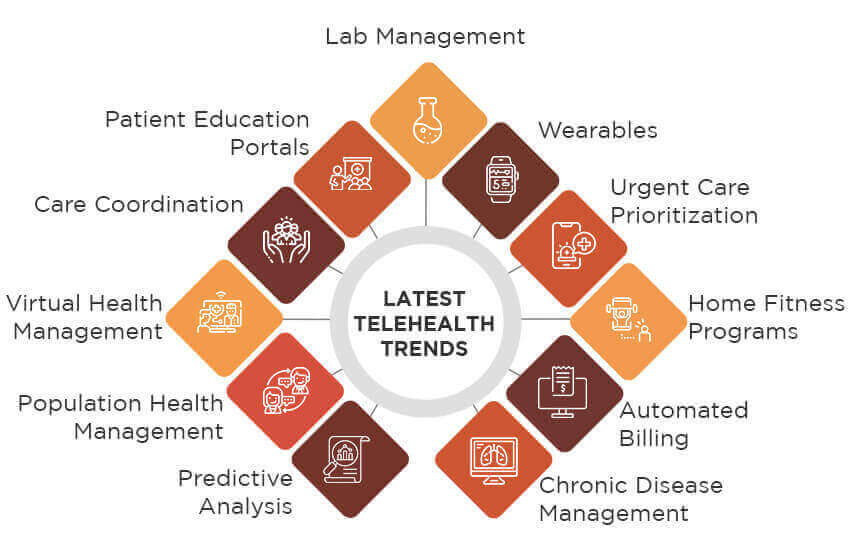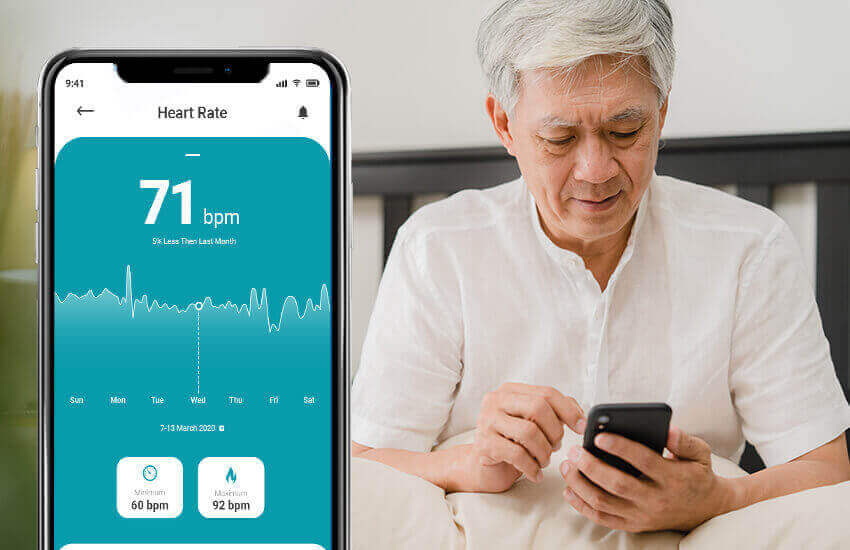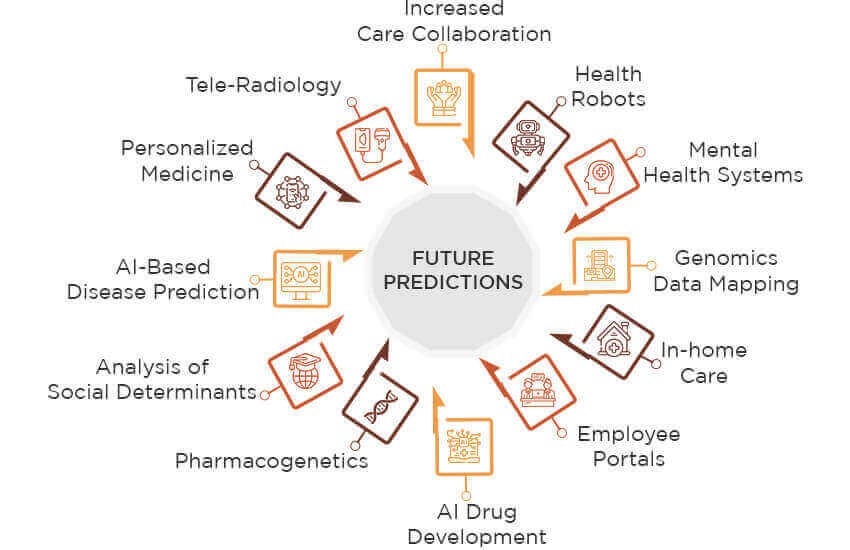Introduction
As a result of the COVID-19 pandemic, the like of which most of us have never or will never witness again, we have come upon the fantastic realization of the meaning of social distancing, quarantines, and remote healthcare. The tide has turned, and technology must get in line. As integrated telehealth solutions continue to witness a favourable outcome, healthcare software product development is increasingly leaning toward telehealth systems. With a continual update, increased patient satisfaction, and high RoI, telehealth software systems usage has multiplied 38X from the pre-Covid days. Here are our predictions on the future of telehealth growth statistics and telemedicine software development trends that will define the upcoming healthcare landscape.
Latest Telehealth Trends

1. Predictive Analysis:
Realizing the real danger of a digital health crisis, telehealth solutions have gained impetus in the predictive analysis of multiple dimensions of healthcare, such as early identification of disease, tailor-made care management, optimizing electronic health records, etc. Custom healthcare software solutions are increasingly addressing this need for predicting future health outcomes. In just a question of 3 months, between February 2020 and April 2020, the telehealth growth statistics boomed 78 times higher for out-patient care.
2. Population Health Management:
The key to preventive care is improving care and adherence by enhancing population health management through intuitive workflows, increased involvement, physician engagement, user-friendly IT solutions, and seamless communication tactics. Therefore, telemedicine applications for healthcare are adopting health care management solutions to address these goals. Recent statistics for telehealth are projected to reach $559.52 billion by 2027, with a CAGR of 25.2%.
3. Virtual Health Management:
Healthcare has adapted to virtual and social distancing strategies, enabled through electronic data interchange, chatbots, video conferencing, etc. Peripheral medical devices, incorporated with telehealth mobile apps, are being used and controlled remotely to enhance telehealth opportunities. According to a recent survey, “in March 2020 alone, American patients who installed and used telehealth applications grew up by 154% in comparison to March 2019. After the peak, this number reached 200 million people.”
4. Care Coordination:
The advantages of increased accessibility and timely action, enabled through telemedicine apps for providers, cannot be ignored. An accurate and common health record is of paramount importance through care coordination, along with structured governance for clinical exchange and the maintenance of patient engagement systems. In the same survey, when asked about usability timeline telehealth statistics, “83% of users report that they do not plan to stop applying such applications even once the global lockdown is over.”
5. Patient Education Portals:
With the onset of telemedicine platforms, the need for online engagement between providers and patients can be enhanced through quantitative surveys and the enhanced marketing of virtual patient education portals. A structured framework in advanced telehealth solutions that minimizes hindrances for the patient and the physician. A market worth $45.5B in 2020 may achieve the mark of $175.7B in 2026.
6. Lab Management:
The urgency of accurate and efficient lab testing modules can mitigate the challenges associated with the evolving nature of healthcare. Automated healthcare solutions applied on telemedicine platforms can replace manual intervention to offer faster results. According to a recent report of telehealth trends and telehealth statistics systems, “IoMT and telehealth apps, by 2029, it will go up to $285.5 billion, compared to $24.4 billion in 2019.”
7. Wearables:
With telehealth apps, remote health monitoring systems are evolving rapidly. Patient monitoring outside of a typical clinical setting is the need of the hour. Wearable devices that can enable real-time tracking are poised for disruption, such as mobile telemetry and continual monitoring software. According to Grand View Research, “The global wearable medical devices market size was valued at USD 16.6 billion in 2020. It is expected to expand at a compound annual growth rate (CAGR) of 26.8% from 2021 to 2028.”
8. Urgent Care Prioritization:
Urgent care is highlighted and prioritized as part of the telemedicine app for doctors. Urgent Care Centers (UCCs) are taking precedence over retail clinics as the former lower cost and increases convenience and accessibility, while the latter involves cumbersome processes and distant locations. Telehealth statistics for doctors display urgent care as a high priority among telemedicine software platforms.
9. Home Fitness Programs:
The rise in telehealth apps for patients has revolutionized how we maintain our fitness levels within the confines of our personal spaces. Home fitness programs are gaining popularity with increased accessibility and convenience, ease of use, and affordability. Open Geeks Lab predicts telemedicine statistics in “the fitness software market will most probably achieve $14.7 bln by 2026, as shared by Market Watch. This industry will increase at a CAGR of 23% in seven years.”
10. Automated Billing:
Systematic processing and policy adherence are established through automated technologies for medical billing and healthcare payment by telemedicine software companies. Telemedicine solutions in billing provide a stable financial environment for revenue cycle management through medical informatics. Telehealth information statistics favor billing automation as the preferred choice in telehealth software for providers.
11. Chronic Disease Management
Chronic diseases have become a major healthcare problem in the United States. More than a third of all adults reportedly suffer from at least one chronic disease, which keeps growing. Telehealth has shown tremendous promise in helping people with chronic diseases manage their conditions better. Telehealth solutions enable people to connect with their doctors remotely, facilitating a rapport. This lets patients receive clarifications regarding any aspect of their treatments without booking appointments and seeing their doctor in person.
The freedom to connect with doctors from one’s own home makes telehealth systems extremely useful for handling chronic diseases.
Can Telehealth Boost the Adoption of Data-Driven Care?

Telehealth uses digital and telecommunications technologies to access and deliver healthcare services. For more than a decade, the idea of telehealth software remained just that, an idea. It took a global pandemic for the scientific and medical community to realize the potential of telehealth. In a nutshell, telehealth allows people to access medical services remotely. They can do so from their homes using their electronics and an internet connection. Telehealth statistics showed a sharp increase in the usage of telemedicine software during this period.
The Covid-19 pandemic saw a surge in the usage of telehealth apps. Most doctors at large hospitals and smaller practices had at least one telemedicine app. Additionally, numerous people too have since downloaded such apps to be able to connect with their providers. The growing penetration of IoT-based wearables has given telehealth solutions a new dimension.
The ability to collect health vitals like blood pressure, glucose levels, and electrocardiogram, among others, has led to a mushrooming of remote patient monitoring programs. These provide a major stimulus to the growth and adoption of telehealth software systems. Real-time collection of patients’ health data and the ease of transmitting them to providers boost the effectiveness of remote care. The data collected over time can be analyzed for valuable insights into patients’ health, the effectiveness of treatments, clinical outcomes, and so on.
Data is the key in this case. It paints a picture of the patient’s medical condition accurately. The more data, the greater the accuracy. Smartwatches that can detect heart rates and electrocardiograms are already being touted as potential indicators of heart attacks. Other information can go a long way in highlighting the risk factor for several diseases. Telehealth statistics indicate the early signs of widespread usage of remote patient monitoring (RPM). As the name indicates, RPM is the observation of patients outside of conventional clinical settings. Remote patient monitoring technology can be said to make up a subset of telehealth. It relies on patient data being collected in real-time and stored in health records for assessment.
It won’t be inaccurate to say that the quality and effectiveness of telehealth programs can be increased with patients’ data. It has less to do with the functionality of the telemedicine software than it has to do with the whole data-driven ecosystem. Patients’ data garnered from devices and transmitted to providers at remote location can help diagnose conditions without needing in-person clinical visits. It is all about data.
The efficiency of the collection, transmission, and storage methods of patient data remotely will determine the direction of the growth of telehealth in this decade. In other words, telehealth depends on data, and the impact of data-driven care will further bolster the adoption of telehealth systems.
Future Predictions in Advanced Telemedicine

Increased Care Collaboration:
As the world moves toward distance caregiving approaches, care collaboration across multiple layers is gaining an impetus like never before. Technological advances and health consumerism will contribute to more effective care coordination through telehealth software companies incorporating practice management solutions. The application of “AI in the medical industry will probably go up quickly in the upcoming few years, exceeding $34 bln by 2025.”
Health Robots:
Digital and robotic technology has already proved its worth in the current crisis and stands popular among telemedicine trends. Drones and robots are set to advance regarding inventory management and delivery in the healthcare sector. The benefits of this technology are accessibility of pharmaceutical delivery to distant locations is undeniable. “Westchester Medical Center reported a 70 percent drop-in Intensive Care Unit C. diff with the use of Xenex Robots.”
Mental Health Systems:
This branch of healthcare will evolve and emerge as a cost-effective and accessible alternative to the traditional therapy model through telemedicine solutions. Telehealth software companies will offer innovative integrated healthcare solutions to manage their mental health disorders. The American Psychiatric Association reveals that “the percentage of Americans saying they would use telehealth services for mental healthcare increased from 49% in 2020 to 59% in 2021.”
Genomics Data Mapping:
This technological innovation applies customized strategic decisions through specific patients’ genomic information. Big data analytics identifies relative patterns and complex correlations by efficiently examining multiple data sets to predict and prevent outbreaks. In statistics for telehealth, “Tractica forecasts that global software revenue from 22 key healthcare AI use cases will grow from $511.7 million in 2018 to $8.6 billion annually by 2025.”
In-home Care:
Exactly as the term states, this trend will offer healthcare at home for patients by skilled medical professionals, ranging from nursing care to multiple therapies. With lower costs, more convenience, and equal effectiveness, this form of caregiving is slowly but surely catching up. Telehealth nursing statistics, according to NCBI, “reported that agencies using telehealth have an average patient-to-nurse ratio of 15:1, as compared with non-telehealth agencies having a ratio of 11:1”. This telehealth nursing statistic indicates decreased nursing costs through higher patient management.
Employee Portals:
Streamlined communication, increased focus on critical initiatives, efficient updating and maintenance of information, enhanced inter-department connections, and process automation are among the many benefits of employee portals that will evolve as a necessity during trying times. Telemedicine software companies can apply healthcare cloud computing towards easy accessibility.
AI Drug Development:
Innovative technologies are aiding pharmaceuticals are being developed at a pace that has never been witnessed before. As part of telemedicine trends, drug development is set to make massive advances through AI-enabled technologies. According to Bloomberg, “a handful of potential drugs identified with the help of AI are in human trials. They include four from Salt Lake City-based Recursion Pharmaceuticals Inc., which is using existing medicines in new ways and raises $436 million in an initial share sale in April 2021.”
Pharmacogenetics:
How a patient’s genetics will affect their reaction to a specific drug has grown exponentially and is a valuable resource in the analysis and administration of caregiving towards community health.
Analysis of Social Determinants:
Environmental factors that affect the population’s health are increasingly coming under the microscope to be studied and analyzed. Governments across the globe are addressing the issue. Toward this end, innovative technologies are being developed.
AI-Based Disease Prediction
The adoption of telemedicine software into the healthcare industry will only increase the rate of collection of patients’ health data. Stats like heart rate, electrocardiogram, body temperature, glucose levels, blood pressure, and others would flow seamlessly from a personalized IoT wearable device into patient’s records. This would enable a remote health monitoring system that uses artificial intelligence to assess the stats.
AI will boost assessment capabilities and generate valuable patient health insights. More accurately, AI can help highlight patients at higher risk of diseases, allowing doctors to take proactive steps to prevent the disease. This type of advanced healthcare informatics could usher in a new era of preventive healthcare. It will also help improve the collection of telehealth statistics.
Personalized Medicine
Not every person is the same. A treatment or regime of medication that worked well for one person might be less effective for another. Different people may respond differently to the same treatment. A look at the prevailing telehealth statistics points towards a future where treatments can be altered for each person. integrated telehealth solutions powered by IoT technologies will boost patient data collection.
The increased trove of data would help improve the analysis accuracy, leading to better insights about each patient’s physical makeup. Such insights will enable providers to take a personalized approach to care for all patients. As a result, there are bound to be fewer side effects or undesirable consequences of treatments for patients. The treatments can be customized according to each patient.
Tele-Radiology
The need for more trained radiologists in rural locations in the United States severely restricts access to care for people living in those locations. This is because radiology is essential for diagnosing several medical conditions and pregnancy. But telehealth software for radiology enables a real-time scan to be transmitted securely to a radiologist at another location. The radiologist can then examine the scan and provide a diagnosis.
This is one of the most exciting applications of advanced telehealth solutions today. The inequity in the access to care between cities and the rural countryside is vast. Telehealth statistics have shown that this can be reduced to a good extent with the adoption of newer technologies. Tele-radiology can enable people living in distant underserved locations to receive the proper diagnosis, which is vital for treatments. Researchers and organizations that compile telehealth statistics often lament the access to care for many people, but innovations in telemedicine software platforms can help boost that access.
Conclusion
As hospitals struggle to manage the rapid inflow of patients during a digital health crisis, telehealth can play a vital role in reducing costs and operating expenses. Beyond that, it also enhances the patient experience through robust automation and analytic tools. It is no wonder that there is a consistent uptick in telehealth information statistics. As we realize the necessity of empowering patients to take charge of their health, this approach enables patients to access and utilize healthcare technology to monitor, report, and record vital information. Telemedicine statistics display that when physician capacity and availability are limited, this approach serves as a boon. Adopting innovative technologies that cater to the needs of changing times is imperative.
References:
https://www.grandviewresearch.com/industry-analysis/wearable-medical-devices-market
https://www.ncbi.nlm.nih.gov/pmc/articles/PMC5993972/
OSP is a trusted software development company that delivers bespoke solutions as per your business needs. Connect with us to hire the best talents in the industry to build enterprise-grade software.

How can we help?
Fill out the short form below or call us at (888) 846-5382
Looking for software solutions to build your product?
Let's discuss your software solutions for your product in our free development acceleration call!
Get In Touch arrow_forwardDiscuss Your Project Handover with a team of expert Book a free consultation arrow_forward
About Author

Written by Riken Shah linkedin
Riken's work motto is to help healthcare providers use technological advancements to make healthcare easily accessible to all stakeholders, from providers to patients. Under his leadership and guidance, OSP Labs has successfully developed over 600 customized software solutions for 200+ healthcare clients across continents.

















